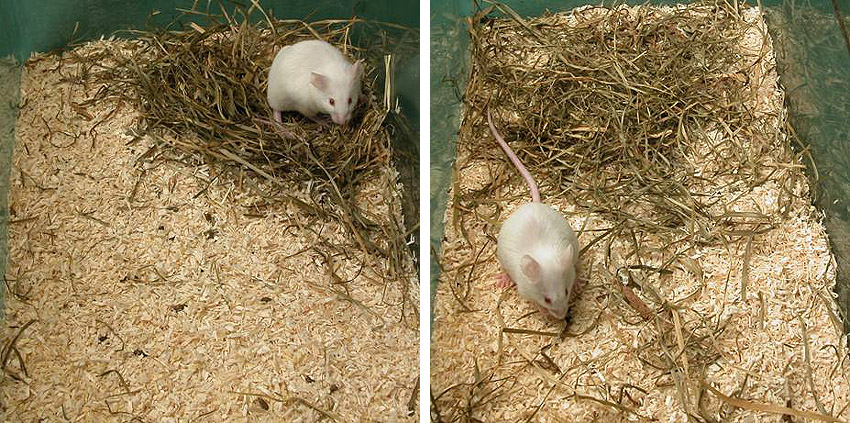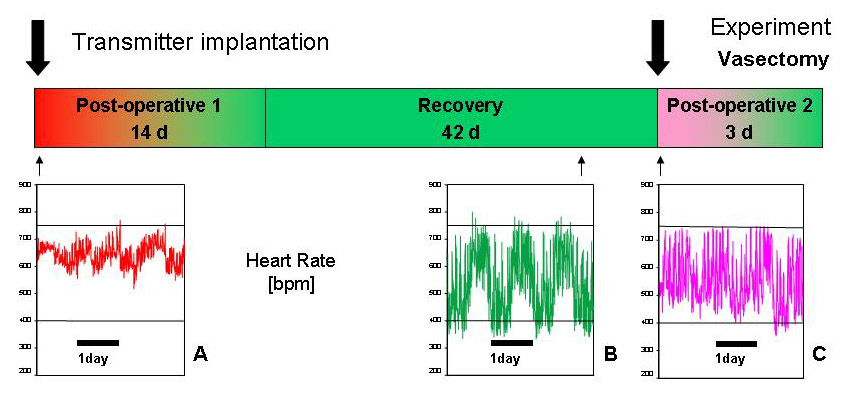 |
3R-INFO-BULLETIN 31
January 2006
Author

Dr. Margarete Arras is head of the animal facility at the Central Biological Laboratory, Institute of Laboratory Animal Science, at the University of Zürich, Switzerland. Beside her responsibility for administration/organization and education/teaching she is involved as a veterinarian in animal experiments and advises researchers on the scientifically justified use of anesthesia, analgesia and euthanasia.
Current address:
Dr. Margarete Arras
marras@bzl.unizh.ch
Institute of Laboratory Animal Science
Central Biological Laboratory
University of Zürich
Sternwartstr. 6
CH-8091 Zürich
Switzerland
Editor
Peter Maier, Scientific Adviser of the 3R Research Foundation
Improvement of Pain Therapy in Laboratory Mice
The ability of animals to feel pain is not completely understood[*] but also the expression of pain via behavioural changes differs from species to species. The alleviation of pain in regulatory and biomedical science is part of the protocols for animal experiments and inherently requires that pain is adequately recognized. In order to provide animal experimenters with better tools for pain recognition, the 3R Research Foundation is supporting projects, which elucidate this uncertainity. Support will continue in a follow-up project 96-05 which is still in an initial state and in the project 88-03 [1]. The present results originate from project 71-00 carried out by Margarete Arras and funded partially by the 3R Research Foundation.
Pain assessment - Different types of pain
Pain assessment in laboratory mice includes the determination of symptoms and indicators of pain and correlating them to the type of pain (e.g. acute vs. chronic pain). Contemporary ways for measuring acute pain are well described for reactions (e.g. withdrawal time, pressure range) on defined, short, stimuli in analgesiometric tests (e.g. tail flick, hot plate). These tests are frequently used for substances and/or analgesics dosage testing, because the read-out is quantified according to defined endpoints.
Acute clinical pain is a different situation which occurs e.g. after surgical interventions carried out in many biomedical animal experimentations, after artificially induced inflammatory reactions (e.g. antibody production, arthritis) or experimental infections for immunological research. Clinical pain, especially in mice, is difficult to estimate, because its quality and duration is influenced by an number of variables, e.g. anaesthesia, the surgeon’s expertise, individual sensitivity, metabolic disorders, etc. In addition, in genetically modified mouse lines the impact of their phenotype on the animal`s well-being is often not known. The consequences are that i) recognizing clinical pain of a moderate degree in mice is based on assumptions and ii) the establishment of a protocol for pain relief and controlling the effectiveness can easily be guesswork.
New approaches for the assessment of clinical pain
Clinical pain is an undesirable variable in research projects. Stressors can disrupt biological functions which might be critical not only to the animal‘s welfare but also to the readout of the experiment. Accordingly one might conclude that in mice, every suspicious manipulation (as little as it might be) must be treated by a standardized pain therapy. But dosages and time course of pain therapy may be poorly adapted to the animal`s needs. The goal of the present study was to develop an approach which is suitable to recognise mild to middle grades of pain during an experiment. In the present study we used NSAIDs as analgesics. The use of opioids would induce physiological and behavioural changes which hamper the assessment of pain by an altered behaviour.
Behavioural approach: Nesting
From daily experience, we couldn’t see any changes in the appearance and behavior of the mice after laparatomy performed during embryo transfer and vasectomy with and without analgesics. Consequently, it was impossible to prove whether the pain killers that we administered routinely, were effective or even necessary to relieve pain. However, when we observed the animals in 12-h-intervals and took drafts of their cages’ appearance, e.g. condition of their nest, we found a clear difference in the animals nest building activities. The un-treated mice destroyed their nests after the operation and needed 3 days to rebuild a proper nest and structure their cage area (Fig.1). The mice that received pain killers damaged their nests negligibly during the first hours after the operation and came out with well-established nests within the first day. This disturbance of nest building behavior was not found in animals which were subjected to anesthesia only. Accordingly it was concluded that the altered behavior can be correlated to the degree of post-operative pain and could be used as a setting that provoke mice to exhibit pain-related behavior. The final goal is to establish tests that are feasible under routine laboratory conditions and could be integrated in specific pain scales and scoring systems used by investigators.

Fig. 1: Mice, 12 hours post-operatively, in their home cage
A well-preserved nest and clear territory structure was found frequently, if post-operative pain was alleviated (left). Damaged nests and several dents, which point to diverse resting places were mainly observed if pain relief was accidentally omitted (right).
Physiological approach: Heart beat rate and variability
In order to detect a sensitive physiological marker for the immediate recognition of pain, we established a telemetry system, in which we used vasectomy as model for mild to moderate post-operative pain. Telemetric transmitters were implanted in adult, male NMRI mice. After 6 weeks of recovery, they were subjected to vasectomy (Fig. 2) followed by the application of two different analgesic regimens (NSAIDs). One group received no analgesics. Post-operatively, none of the animals exhibited overt clinical signs of pain. Locomotor activity remained stable in all groups, which confirms the absence of intolerable pain. Body core temperature showed negligible increase (below 0.5°C), suggesting that post-surgical inflammation was of no influence. Nevertheless after vasectomy in the group with no NSAIDs, the heart beat rate and variability measures increased, particularly during the daylight phase, and food consumption and body weight curves decreased by 20% respectively 2-3%.These changes were not seen in the two groups that received high doses of NSAIDs for pain therapy [6] or in control groups subjected to anesthesia and analgesics/vehicle administration only. We concluded that heart beat rate is a pain-related symptom which allows to detect in real-time low to middle-grade post-surgical pain and accordingly the effectiveness of the analgesic regimen in mice.

Fig. 2: Experimental schedule and real-time heart rate curves
A) Elevated heart beat values (up to 650 bpm) over a 3 day period (diurnal rhythm) after transmitter implantation despite NSAID analgesic. B) Following a higher dose of NSAID, almost normalized cardiac rhythm and normal circadian fluctuation were measured similar to the recovery phase. C) A slight increase of heart rate during the daylight (resting) phase after vasectomy without analgesics indicates mild pain, which can be reduced completely with NSAIDs.
Molecular approach in the future: Pain-associated gene regulation?
Using the telemetric measurements, we were able to define time points at which the mice experienced pain. Accordingly the expression of genes involved in pain processing should be altered when compared to tissues from animals without pain. We designed a low-density microarray with over 100 selected genes involved in pain and distress. Preliminary results from hybridizations with material obtained after vasectomy indicate changes which correlate with pain management.
Benefit for mice, men and science
The combined behavioural, physiological and molecular approach in mice will provide tools for the experimenter to recognize moderate and mild clinical pain. Ideally he/she will be enabled to judge the degree of pain more precisely and to apply and control the effects of clearly targeted pain relief protocols. As a result, less side effects will be expected from pain-related physiological changes in the animal (e.g. increased stress hormone levels, complicated wound healing) and analgesics-induced adverse effects (e.g. bleeding, behavioural aberrations) will be limited to the level necessary for effective pain relief.
Published updated version of this Bulletin 31/2007 (PDF)
References:
- Flecknell P. et al. Assessing animal health and welfare and recognising pain and distress; Tutorials Assessing the Health and Welfare of Laboratory Animals, University of Newcastle, UK, 2005 (see http://www.ahwla.org.uk).
- Stasiak, K.L., et al., Species-specific assessment of pain in laboratory animals. Contemporary Topics in Laboratory Animal Science, 2003. 42(4): p. 13-20.
- Peterson, N.C., Assessment of pain scoring. Contemporary Topics in Laboratory Animal Science, 2004. 43(1): p. 74.
- Van Sluyters, R.C., Obernier, A., Guidelines for the care and use of mammals in neuroscience and behavioral research. Contemporary topics in laboratory animal science, 2004. 43(2): p. 48-52.
- Hohmann, A.G., et al., An endocannabinoid mechanism for stress-induced analgesia. Nature, 2005. 435 (7045): p. 1108-1112.
- Arras, M., Rettich, A., Kasermann, H. P., Cinelli, P., Buerki, K., 2005. Assessment of post-operative pain in laboratory mice by telemetry (Abstract). ALTEX, 22 (Special issue: Abstracts 5th World Congress 2005): p. 42.
| [*] | Pain and Animal Experimentation:In 1985, the U.S. Interagency Research Animal Committee (IRAC) advised that “unless the contrary is established, investigators should consider that procedures that cause pain or distress in human beings may cause pain or distress in animals”(http://www.aclam.org/pub_pain_distress.html). Accordingly, the humane use of research animals requires adequate veterinary medical care during animal experimentations and includes the prevention or the alleviation of pain associated with procedural or surgical protocols (clinical pain). Guidelines on the recognition of pain are accepted by researchers but often not so easy to put into practice, especially with mice, the most frequently used laboratory animals. Why? Mice live in constant fear of falling prey to their enemies, therefore they are prone to show as few signs of disease, suffering or weakness as possible [2-4]. Accordingly, during animal experiments, or even when a person is simply present in the room, the mouse will hide almost all signs of light or middle-grade pain. Additionally, endogenous stress-induced analgesic systems that are well developed in mice affects their responses to pain and therefore complicate the recognition of the actual degree of pain [5]. Decreased food intake or loss of body weight are retrospective indicators of pain or stress and therefore not suitable per se. In consequence, there are no reliable indicators to detect low and middle-grade clinical pain in the mouse. The appearance of clinical signs (e.g. changes in posture, fur or eyes) often represents severe pain appearing sometimes at a nearly moribund state which has to be terminated by euthanasia. Another consequence of the dilemma is that even a successful analgesic treatment cannot be monitored well and uncertainty remains about the efficacy of many analgesic regimens. Accordingly, more research is necessary to improve the recognition and justification of pain in laboratory mice. |
| Dernières modifications: 30.01.2008 |